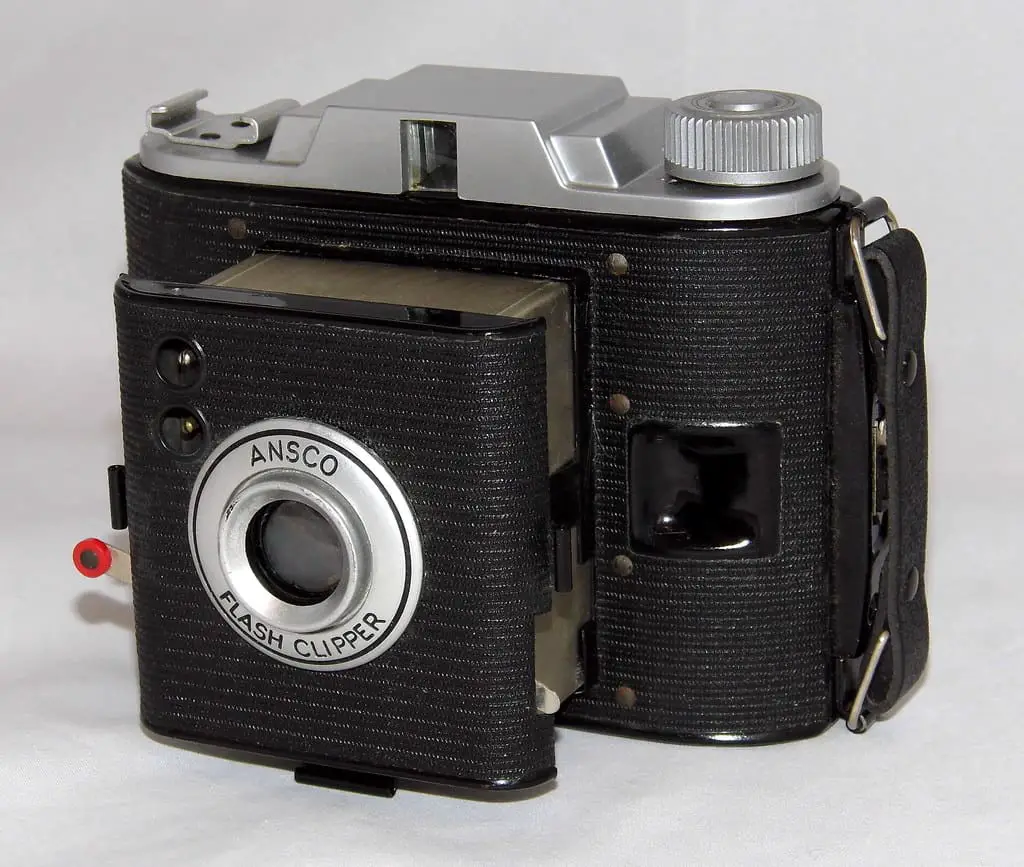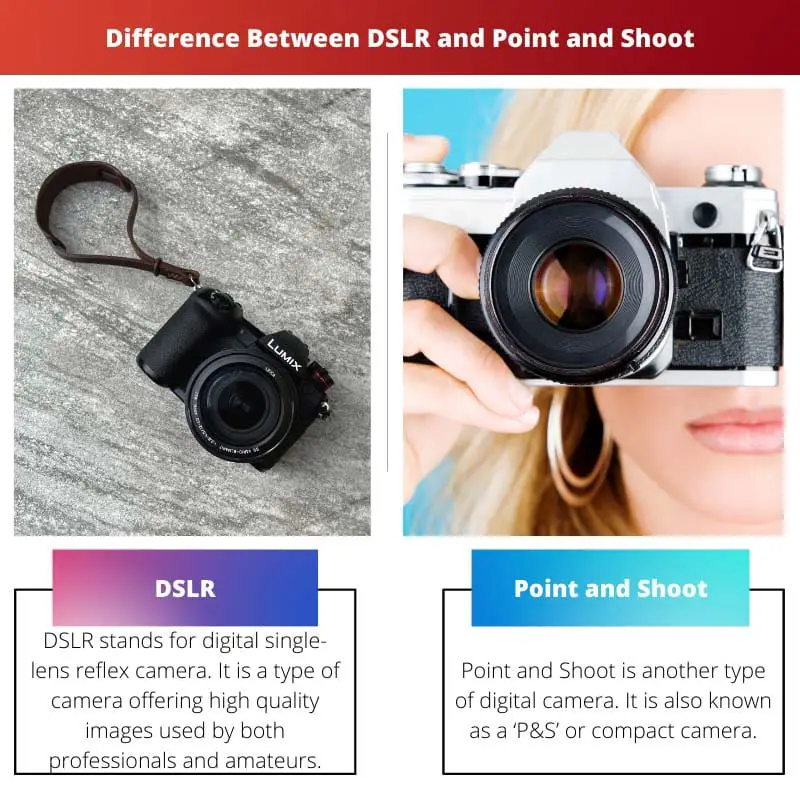The term ‘camera’ is used to refer to a device that is used to take pictures or videos. It comprises a lightproof chamber with a lens and shutter.
Various types of cameras are used for professional or daily use, like mirrorless, film, smartphones, and many others. The camera used by different people depends on their needs and preferences.
Key Takeaways
- DSLRs (Digital Single-Lens Reflex) cameras offer interchangeable lenses, manual control, and superior image quality.
- Point-and-shoot cameras are compact with fixed lenses, catering to casual photographers.
- DSLRs cater to professionals and enthusiasts, while point-and-shoot cameras appeal to beginners.
DSLR and Point and Shoot
DSLR cameras are designed for professional and advanced photographers and offer a wide range of manual controls, fast autofocus, and interchangeable lenses. Point-and-shoot cameras are designed for casual photographers who want a camera that is easy to use and convenient to carry, with fewer manual controls.

DSLR stands for digital single-lens reflex camera. It is a type of camera offering high-quality images used by both professionals and amateurs.
It allows one to take a close look at the picture and visualize the same through the viewfinder. It is the perfect amalgamation of a single-lens reflex camera and a digital imaging sensor.
Point and Shoot is another type of digital camera. It is also known as a ‘P&S’ or compact camera. It is a simple, automatic digital camera perfect for people wanting better pictures than a smartphone at affordable prices without any complexity of a lavish camera.
This is because of its built-in zoom lens and flash.
Comparison Table
| Parameters of Comparison | DSLR | Point and Shoot |
|---|---|---|
| Use | Used by professional photographers and hobbyists | Best for casual use |
| Level of skill required | Higher as compared to point and shoot; knowledge of techniques required | Lower in comparison to DSLR cameras; very simple to use |
| Manual Control options | Offers many manual control options | Works best with automatic settings |
| Customisation | Allows many finely tuned settings | Not many customisations available |
| Size | Heavier and larger | Smaller and lighter |
| Format of pictures | RAW, JPEG or TIFF | JPEG |
| Preview of shots | Available | Lacking |
| Cost | Expensive | Comparatively less expensive |
What is DSLR?
DSLR is a high-end camera used by all professional photographers. It is the most popular type of camera. The quality of images captured by it is 1000 times better than a regular smartphone picture making it perfect for professional use.
It has the capability of capturing 10 shots per second. It has customisation options available with different sensor sizes. It has interchangeable lenses, which come in handy to meet our various needs.
Unlike digital cameras, these interchangeable lenses provide more manual control and more options. A DSLR camera has a bigger sensor than most cameras providing better image quality.
Its pictures have less noise allowing photographers to work in very low light conditions. It also has a viewfinder allowing us to take a good look at the pictures before capturing the shot.
The best part about DSLR cameras is that they can be used without any problems in extreme weather conditions. It works best while taking landscape pictures.
It has the power to stand snow, dust, moisture, rain and severely cold weather. However, DSLR cameras are heavy and are not easy to maintain and use. Canon and Nikon are the market leaders in this segment. Fuji, Sigma and Pentax also provide DSLRs.

What is Point and Shoot?
Point and Shoot is another type of digital camera. These easy-to-use cameras are most suitable for casual needs like vacation pictures or documentary creation. Coming with variable focal length and fixed lens, it does not offer many customisation options.
These cameras have zoom lenses that are already built in. It comes with image stabilization, perfect for casual photographers who are comfortable with automated settings and do not want to worry about the settings.
Some manual settings are provided, but it works best with automated ones.
These cameras are the most affordable options. Many times, they are available at a price lower than a smartphone. These are quite comfortable to travel with due to their sleek and compact design, making them easy to put anywhere.
However, due to the small size, the quality of images is not as good as DSLRs. These cameras cannot be upgraded in terms of external accessories and the camera’s original features.
They provide a large depth of field, putting the whole scene in focus. On the other hand, due to the large depth, the foreground cannot be separated from the background. They do not work best for shooting at night.

Main Differences Between DSLR and Point and Shoot
- DSLR cameras are high-end cameras used by professional photographers and hobbyists. On the other hand, point-and-shoot cameras are digital cameras used by casual photographers.
- To use a DSLR camera, one needs to be equipped with all the technological know-how. Though, novices can even use point-and-shoot cameras.
- DSLR cameras offer manual control options, which are not the same as point-and-shoot cameras.
- DSLR cameras are larger and heavier in weight, whereas point-and-shoot cameras are lighter and smaller. Point-and-shoot cameras can fit anywhere and occupy a very small space.
- DSLR cameras are comparatively more expensive than point-and-shoot ones.
- The format of pictures in DSLR is RAW, JPEG or TIFF, whereas point and shoot provides pictures in JPEG format only without providing a preview of shots.


A comprehensive and well-structured article. The use of DSLRs and Point and Shoot cameras, leads to confusion, but after reading this article, I’ve gained a clearer understanding of their implications.
Thank you for sharing this informative article! As an enthusiast in photography, I always appreciate learning new details about different types of cameras. Looking forward to reading more in-depth articles like this.
Agreed! I appreciate how this article clearly outlines the key differences and features of DSLR and Point and Shoot cameras. It’s a great resource for anyone wanting to understand the topic further.
This was an excellent read. The comparison table and detailed explanations were very enlightening. Looking forward to more content like this!
Informative and well-articulated. The article provides a clear breakdown of DSLR and Point and Shoot cameras, catering to both professionals and beginners at the same time.
What a helpful article! I have always wondered about the main differences between a DSLR and Point and Shoot cameras. This explained everything I needed to know.
The references provided in this article underline the credibility and depth of information. I appreciate the effort put into researching these resources to support the content.
Very well-written. The explanation of key takeaways, comparison table, and main differences were detailed and proficient. This article is a valuable piece for individuals interested in photography.
This article offers a thorough comparison between DSLR and Point and Shoot cameras. It’s informative and well-researched. I definitely learned something new from this piece.
Brilliant article! The detailed description of the differences between DSLR and Point and Shoot cameras is enriching and insightful. It’s articles like this that enhance the reader’s knowledge of the subjects.